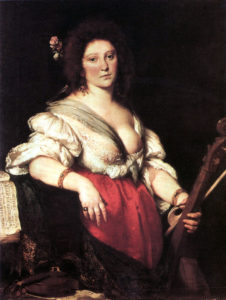Here is my translation of the lyric to the aria “Che si può fare?” by Barbara Strozzi (1619-1677) published in 1664 in her Opus 8 collection. I have tried to make the translation singable in English, by matching the positions of the words in the music. I like it in Italian but I would also like to hear it sung in English and perhaps that way it could reach more people.
The complete lyric is longer than the part presented and translated here. This translation has just the portions of the lyric that are in the musical performance in the video on this page.
The best online resource is Barbara Strozzi dot com, edited by Dr. Candace Magner. It has the most information and an extensive bibliography. Fine editions of Barbara Strozzi’s scores can be ordered from Cor Donato Editions, including the complete set of Opus 8, which includes Che Si Può Fare.
This song is from 1664 so it is about 70 years older than most of the music we normally ever hear, yet to me, it sounds surprisingly modern. Listen to the performance in the video on this page and imagine how this song could sound in English, sung by anyone you can think of.

This is believed to be a portrait of Barbara Strozzi. Called “The Viola da Gamba Player” by Bernardo Strozzi (relation uncertain), it is in the Gemäldegalerie in Dresden, Germany (and is in the public domain).
Che si può fare? / What Can I Do?
Translation (c) 2017 Chris DiMatteo. All rights reserved.
What can I do?
The stars have no pity and work against me;
If heaven will give me no gesture
Of peace for my pain,
What can I do?
What can I say?
The heavens are raining disasters on me;
If Love will not grant me a moment of breath,
to relieve all my suffering,
What can I say?
Che si può fare? (original Italian text)
Che si può fare?
Le stelle ribelle non hanno pietà;
se ‘l cielo non dà un influsso
di pace al mio penare,
che si può fare?
Che si può dire?
Dagl’astri disastri mi piovano ognor;
se perfido amor un respiro diniega
al mio martire,
che si può dire?
There are many performances of Barbara Strozzi’s “Che si può fare?” on YouTube. Although it is abbreviated, here is my favorite one, by the excellent group Concerto delle Donne, which is based in Amsterdam in the Netherlands.
Barbara Strozzi Then and Now
Barbara Strozzi was a famous musician, singer and composer in Venice, which was a very lively and rich city in the 1600s. She was one of the leading composers and by her own efforts, the most published woman composer of her time. In the 1600s music was changing, with the innovations of the “seconda pratica” led by Claudio Monteverdi and Francesco Cavalli. Barbara Strozzi is one of the finest practitioners of this new style or “second practice” as literally translated.
The new style of the 1600s is the foundation of what sounds like modern music to our ears. Despite the beauty, variety and abundance of this music, we hear little of it today. The oldest music we usually hear on the radio, on recordings and in concerts comes from the early to mid-1700s, such as Handel’s Water Music suites (1717), J.S. Bach’s Brandenburg Concertos (1721) and Vivaldi’s Four Seasons (1725).
A score of Che si può fare? can be downloaded from this page here, in a free PDF edition, but it is shortened and not in the original key of E minor. See the Cor Donato Editions book of Opus 8 for the complete correct score edited by Dr. Candace Magner.
Che si può fare? is a passacaglia. In the performance above, it is played in D minor, although the original key is E minor. A passacaglia is a musical form played over a repeating bass note pattern. Here are the notes of the bass line, from the score of Che si può fare?
This bass line consists of the first four notes of a descending D minor scale. They happen to be identical to a bass line used in blues and jazz in the 20th century, three hundred years later. For example, this bass line is in “Hit The Road Jack” by Percy Mayfield popularized by Ray Charles, and in Roland Kirk’s “Serenade to a Cuckoo.” This is an easy and familiar bass line for the left hand on piano or for the bass in a group.
Thanks to some recent scholarly research, we know a lot more about Barbara Strozzi today than ever before, and thanks to the Internet we have access to a lot of her music, in both written scores and recordings of performances. I will not attempt to summarize her very interesting biography. Instead, see the section A Brief History at Barbara Strozzi dot com.
This wikipedia page is concise and also has a bibliography. There are shorter bios, here and here but they don’t list any sources.

